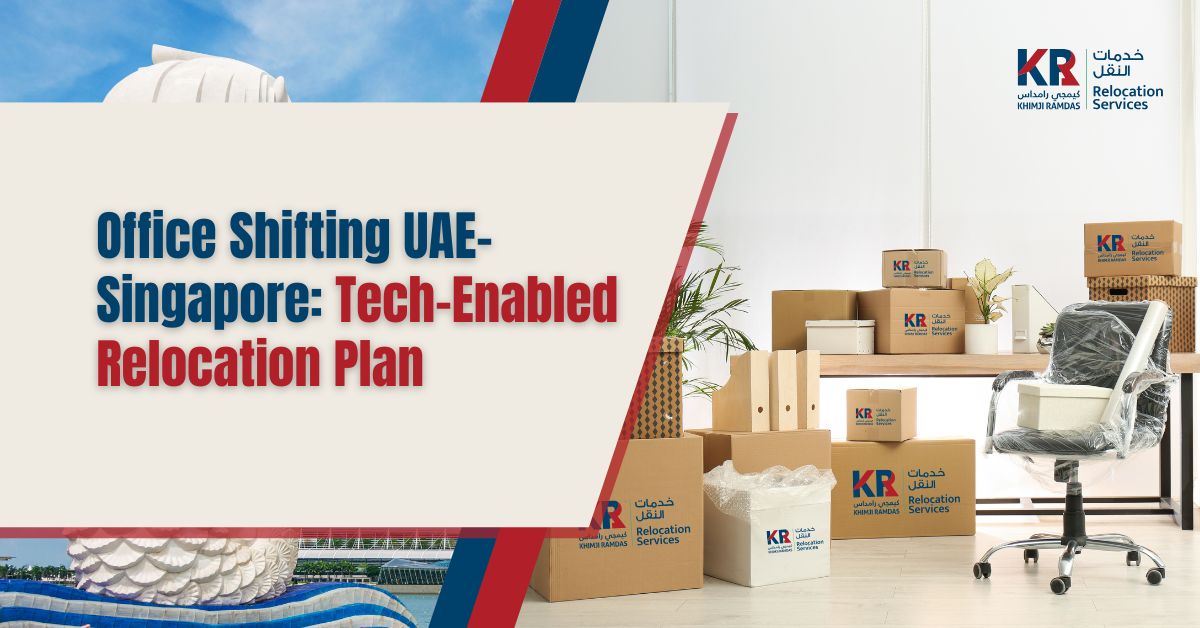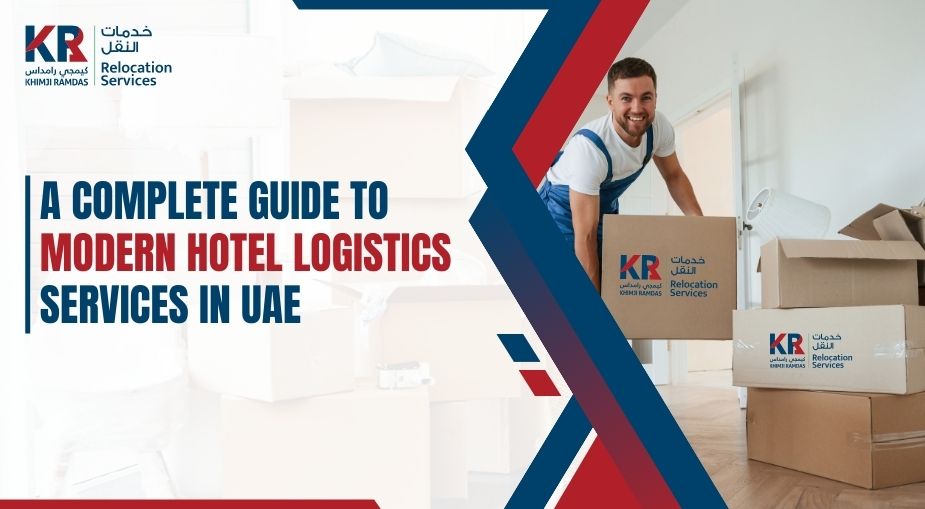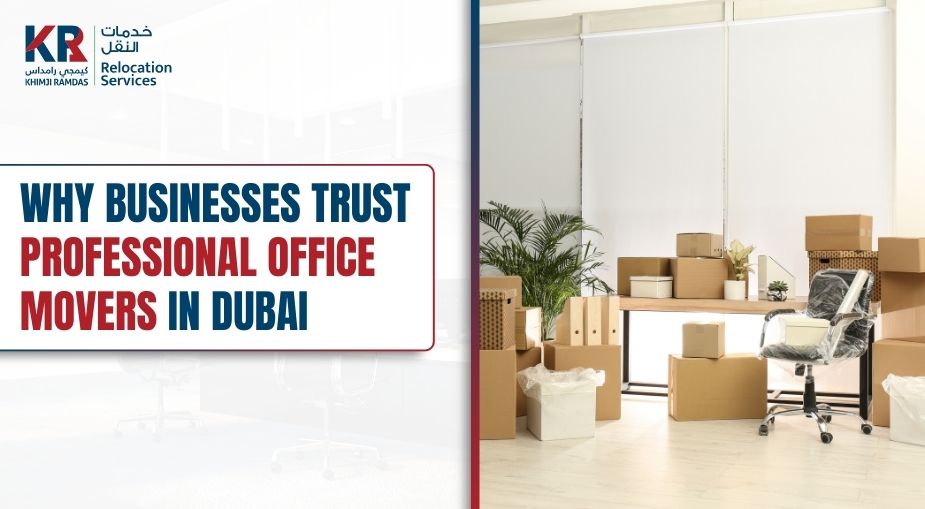Office Shifting UAE-Singapore: Tech-Enabled Relocation Plan

Office shifting from the UAE to Singapore is no longer just about packing desks and moving furniture—it’s about orchestrating a well-planned, technologically-supported transition that ensures minimal disruption to business operations.
As companies expand beyond borders, the demand for streamlined office relocation between dynamic business hubs like Dubai, Sharjah, Abu Dhabi, and Singapore is on the rise. These cities are not only economic powerhouses but also gateways to larger global markets. As a result, shifting your office across international boundaries comes with high expectations around speed, security, and strategic execution.
What sets apart modern office shifting projects is the role of technology in simplifying what was once an overwhelming and error-prone process. From AI-driven move management to cloud-based communication tools, technology is redefining how organizations move. It’s not just about physical transition; it’s about sustaining productivity and ensuring business continuity throughout the move.
This article breaks down how to master your UAE-to-Singapore office shifting journey with the help of a tech-enabled relocation plan. Whether you’re moving a startup or a regional HQ, preparation, precision, and the right partners make all the difference.
Mastering Office Shifting: UAE to Singapore with Precision
The process of office shifting involves far more than just logistics. It demands a full-scale operation that addresses organizational structure, digital infrastructure, and the well-being of employees. A successful shift from cities like Dubai, Sharjah, or Abu Dhabi to Singapore starts with understanding the unique nature of corporate relocation.
The Distinct Nature of Office Shifting
Unlike home moves, office shifting involves transferring complex networks, sensitive data, confidential documents, and IT systems—all while keeping the business up and running. A lapse in this process can lead to lost revenue, damaged reputation, and potential legal risks.
Each component in the workplace, from individual workstations to centralized data servers, plays a critical role in daily operations. Coordinating their relocation safely and efficiently is where the challenge lies. Office shifting needs a carefully structured roadmap to ensure no system is left behind and no team is left disconnected.
Strategic Reasons Behind UAE-to-Singapore Office Moves
Companies across the UAE—especially in cities like Dubai, Sharjah, and Abu Dhabi—are increasingly shifting operations to Singapore due to its business-friendly environment, low corporate tax rate, and strategic location in Southeast Asia.
For some, this move is about expanding into new markets. For others, it’s about consolidating operations in a digitally advanced region. Either way, office shifting in this context is not just a physical relocation—it’s a strategic evolution of business. It opens doors to greater talent pools, better connectivity, and stronger regional influence.
Understanding these drivers helps in tailoring a relocation plan that’s not only logistically sound but also aligned with business growth goals.
Building a Tech-Enabled Office Relocation Plan
To handle office shifting efficiently, businesses must go beyond traditional relocation checklists. The introduction of technology has transformed how companies plan, manage, and execute their moves—making them faster, smarter, and more secure.
Digital Inventory and Asset Tracking
One of the most crucial elements of office shifting is knowing exactly what is being moved and where it will go. Digital inventory tools help log every piece of office equipment, document, and asset—eliminating the guesswork.
These tools use barcodes and scanners to provide real-time updates and tracking. Managers in both UAE and Singapore can instantly see what’s been packed, what’s in transit, and what’s arrived. This ensures accountability and reduces the risk of misplaced assets.
In an international office shifting project, especially across busy business centers like Dubai or Singapore, digital inventory management adds transparency and structure to an otherwise chaotic process.
AI-Powered Relocation Management Platforms
Artificial intelligence is revolutionizing how we approach office shifting. Modern relocation platforms use AI to automate route planning, schedule coordination, and workflow optimization.
For example, AI can analyze traffic patterns to choose the best times for transit or suggest the optimal sequence for moving departments to minimize downtime. It can also assign tasks to team members, monitor progress, and flag potential delays in real time.
In UAE-to-Singapore transitions, where time zones and compliance rules come into play, AI helps unify planning across regions. This keeps office shifting on schedule and within budget.
Cloud-Based Communication and Collaboration Tools
Keeping teams connected during office shifting is critical. Cloud tools such as project dashboards, video conferencing platforms, and real-time chat systems allow continuous collaboration even when teams are split between locations.
Whether your HR team is still operating from Abu Dhabi while IT is setting up in Singapore, cloud platforms ensure seamless communication. Updates can be shared, issues can be resolved, and timelines can be adjusted instantly.
These tools are particularly useful when paired with your relocation partner, such as Khimji Ramdas Relocation Services, to maintain alignment between your internal team and the external moving experts managing the office shifting on both sides.
IT Infrastructure Relocation: Doing It Right
In any office shifting project, IT infrastructure is one of the most critical and sensitive components. Transferring cables, servers, hardware, and software setups from the UAE to Singapore without disrupting operations takes thorough planning and technical accuracy.
The Importance of Pre-Move IT Audits
Before initiating the physical move, businesses must conduct an in-depth IT audit. This audit evaluates all hardware and software assets, maps dependencies, and identifies what needs to be relocated, upgraded, or retired.
During office shifting, skipping this step often results in confusion at the destination. For instance, moving outdated or non-functional equipment wastes valuable time and resources. By auditing everything beforehand, organizations ensure that only necessary, high-performance equipment makes the journey.
This approach is especially vital when relocating from tech-driven hubs like Abu Dhabi or Dubai, where IT systems are often complex and highly customized. The audit creates a clear roadmap that aligns with relocation priorities.
Server and Data Center Relocation
Relocating servers, data centers, and networking gear demands precision and zero tolerance for error. A single oversight can disrupt data flow, cause application outages, or create compliance violations.
In office shifting, this stage includes secure disassembly, packaging, and transport of sensitive tech components. These assets must be climate-controlled during transit and protected against static damage, theft, or misplacement.
The transition from UAE to Singapore also requires coordination with telecom providers and data hosting services to minimize disruption. Timing the migration to occur outside core operational hours reduces the risk of service loss and keeps internal stakeholders productive.
Reconfiguration and Testing at Destination
After equipment arrives at the new Singapore office, the next step is setting up and testing systems before employees start working. Reconnecting servers, configuring networks, and verifying software functionality ensures everything is operational from day one.
In any international office shifting process, reconfiguration is where surprises can surface—unfamiliar infrastructure, incompatible connections, or delays in equipment clearance. To counter this, advance site assessments and mock setups help smoothen the switchover.
Partnering with experienced relocation providers like Khimji Ramdas Relocation Services—who understand the technical complexities involved—can ensure the destination office is fully functional, secure, and compliant from the outset.
Minimizing Downtime with Smart Scheduling
Downtime is one of the biggest fears during office shifting, especially when relocating across borders. Lost productivity, missed deadlines, and operational gaps can significantly affect revenue. A well-timed schedule can reduce these risks dramatically.
Weekends, Holidays, and After-Hours Moves
One of the most effective ways to manage office shifting without interrupting daily operations is by scheduling the move outside regular business hours. Weekend or holiday relocations allow teams to return to a fully operational setup by the next workday.
This method is particularly effective for UAE-based businesses in cities like Sharjah and Dubai, where weekday schedules are often tightly packed. It provides a natural buffer for unexpected delays, ensuring continuity once operations resume in Singapore.
However, planning an after-hours move requires advance coordination with building managers, local authorities, and transport agencies in both countries. A detailed calendar that accounts for public holidays in both UAE and Singapore ensures that every stage is executed smoothly.
Staggered Shifting and Parallel Workflows
Rather than moving everything at once, staggered shifting allows companies to phase out the transition by department, function, or urgency. For example, critical departments such as IT and finance can be relocated first, followed by administrative or creative teams.
This phased model reduces the pressure of a single deadline and keeps essential functions running throughout the transition. In large-scale office shifting operations, staggered plans enable smoother communication, better risk management, and improved control.
Creating parallel workflows is another technique that helps. While teams prepare for the move, operations can continue from backup systems or satellite offices. This ensures that customer service and project delivery are not disrupted during the relocation phase.
Compliance and Customs for Cross-Border Office Shifting
When office shifting involves two countries with different regulations, understanding and complying with customs, import rules, and local business laws becomes a priority. Failure to address these requirements can result in costly delays, fines, or denied entries for critical equipment.
Navigating UAE and Singapore Regulations
Each country has its own set of compliance standards for moving commercial assets. In the UAE, export documentation, equipment declarations, and customs inspections are mandatory before departure. Singapore, on the other hand, requires import permits, duty calculations, and health and safety checks for incoming shipments.
During office shifting, it’s essential to prepare documentation such as commercial invoices, certificates of origin, and packing lists well in advance. Clearance delays often occur due to incomplete paperwork or misclassified items, which can impact the overall timeline.
Understanding customs requirements at both ends ensures that the transition from places like Abu Dhabi or Dubai to Singapore is as smooth as possible. Timely submission and proper packaging can prevent unnecessary scrutiny and facilitate faster approvals.
Role of Relocation Partners in Streamlining Compliance
A seasoned relocation partner, such as Khimji Ramdas Relocation Services, can simplify the entire compliance process. Their expertise in managing cross-border regulations and documentation ensures that office shifting stays on track without unnecessary roadblocks.
They assist in gathering, verifying, and submitting paperwork, coordinating with customs officers, and resolving any compliance issues that arise during transit. This hands-on support is especially beneficial when moving sensitive IT infrastructure or high-value office equipment that requires special declarations.
Relocation providers also stay updated on changes in international moving laws, ensuring your office shifting project is aligned with current trade and business regulations. This helps businesses focus on resuming operations instead of being bogged down by administrative hurdles.
Why Choose Khimji Ramdas Relocation Services
When planning a cross-border office shifting operation, choosing the right relocation partner can make or break the process. Khimji Ramdas Relocation Services offers unmatched expertise and localized knowledge that helps businesses transition smoothly from the UAE to Singapore.
Trusted Office Shifting Experts Across UAE
With a strong presence in Dubai, Sharjah, and Abu Dhabi, Khimji Ramdas Relocation Services is deeply familiar with the logistics, compliance requirements, and business culture across all major UAE cities. This localized presence ensures faster response times, better planning, and tailored relocation support for office shifting needs.
Whether a business is headquartered in Dubai’s tech hubs or Sharjah’s industrial zones, the same high-quality service and precision apply. Office shifting becomes a structured and organized process, thanks to their professional teams who understand every nuance of regional and international relocations.
Tech-Driven, People-Centered Approach
What sets Khimji Ramdas Relocation Services apart in the office shifting landscape is their ability to merge technology with human expertise. From digital inventory systems to real-time tracking tools, their relocation process is engineered for visibility, speed, and safety.
However, technology alone doesn’t move businesses—people do. That’s why their teams focus equally on client communication, staff preparedness, and hands-on assistance at both ends of the move. Office shifting, especially across countries, needs this balance between automation and personal support to ensure zero disruption.
End-to-End Support for Seamless Transitions
Khimji Ramdas Relocation Services offers comprehensive solutions that begin with pre-move audits and end only after full setup and testing at the new Singapore location. Their project managers coordinate everything—packing, transport, customs clearance, and office installation—under one roof.
This full-cycle service eliminates the need for multiple vendors and makes office shifting far more predictable and efficient. With experts managing each phase, companies can focus on strategy, not logistics. The result is a seamless transition into a new operational environment with minimal stress and downtime.
Read Also: Professional Fine Arts Shipping in Sharjah You Can Trust
Wrapping Up
Office shifting from the UAE to Singapore is no small feat. It requires planning, timing, and technical accuracy, all executed within a framework of regulatory compliance and business continuity. As global workspaces evolve, companies can no longer rely on traditional relocation models to manage complex transitions.
By leveraging smart tools like AI planning platforms, cloud-based communication systems, and digital inventory tracking, businesses gain a clear edge in execution. Technology doesn’t just support office shifting—it drives it, reducing risks and maximizing control.
Choosing an experienced, tech-enabled partner like Khimji Ramdas Relocation Services ensures that every element of your move—from IT setup in Abu Dhabi to furniture installation in Singapore—is handled with precision. With dedicated teams in Dubai, Sharjah, and Abu Dhabi, their services are built for regional strength and global reach. We also offer the best storage solutions for moving.
If you’re considering office shifting as part of your business expansion or optimization, now is the time to make your move smart, strategic, and seamless.
Frequently Asked Questions (FAQs)
At Khimji Ramdas Relocation Services, we understand that moving—whether locally in the UAE or internationally—comes with many questions. Our FAQs provide expert insights on everything from household and office relocations to pet moving, storage solutions, and more. With a commitment to seamless, stress-free transitions, we ensure a smooth relocation experience across Dubai, Abu Dhabi, Sharjah, and beyond. Explore our FAQs to get trusted answers from one of the leading moving companies in the region.
What is the best way to plan an office shifting from UAE to Singapore?
The best approach involves early planning, digital inventory tracking, phased scheduling, and working with a relocation expert like Khimji Ramdas Relocation Services to manage logistics and compliance.
How can we move IT equipment safely during an office shifting?
Begin with a comprehensive IT audit, use anti-static packaging, and engage specialists to handle disassembly, transport, and reinstallation under secure, climate-controlled conditions.
What documents are needed for office shifting between countries?
Documents typically include packing lists, commercial invoices, import/export permits, and certificates of origin. A relocation partner can help streamline documentation to avoid delays.
How long does international office relocation typically take?
Office shifting timelines vary by scope, but a UAE to Singapore relocation may take 1–3 weeks, including planning, transport, and reinstallation phases.
Can office shifting be done over weekends to avoid disruption?
Yes, weekend or after-hours scheduling is common practice to minimize downtime. This allows business operations to continue with minimal interruption.
How do I choose a reliable office shifting service in UAE?
Look for licensed relocation providers with regional experience in Dubai, Sharjah, and Abu Dhabi, a track record of international moves, and tech-enabled systems for tracking and communication.
What are the common challenges in cross-border office relocation?
Key challenges include customs clearance, downtime management, IT reinstallation, and coordinating teams across locations. Professional support mitigates these risks during office shifting.

Explore Our Most Revelent Articles
With a dedicated single point of contact offering comprehensive, tailored solutions, streamlined processes, and a network of suppliers, we ensure a superior relocation experience. Our commitment to excellence ensures that every aspect of the relocation process is efficiently managed, delivering satisfaction to our clients.

A Complete Guide to Modern Hotel Logistics Services in UAE
Explore hotel logistics services in the UAE, learn how Khimji Ramdas Relocation Services supports hotels in Dubai, Sharjah, Abu Dhabi with efficient logistics.

Why Businesses Trust Professional Office Movers Dubai
Businesses trust office movers Dubai for secure, efficient relocations. Learn how Khimji Ramdas Relocation Services ensures smooth corporate moves across UAE.

Top Tips for Hiring the Best Packers and Movers in Abu Dhabi
Hiring packers and movers in Abu Dhabi? Get expert tips to compare quotes and choose trusted professionals like Khimji Ramdas Relocation Services.
